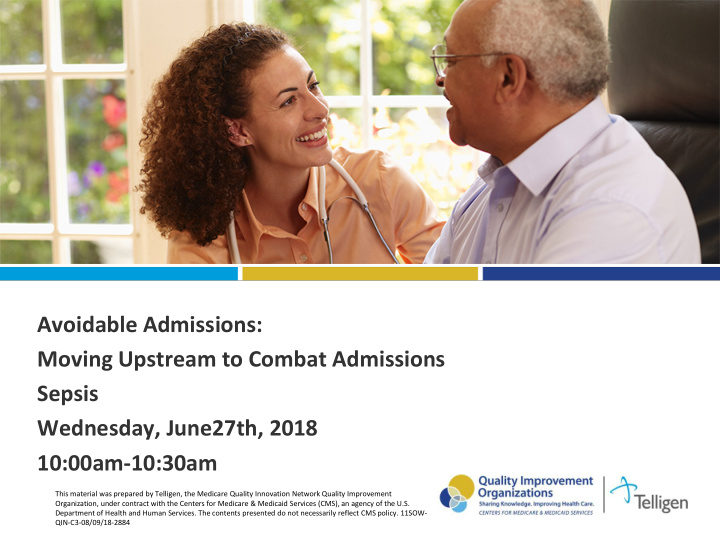



Avoidable Admissions: Moving Upstream to Combat Admissions Sepsis Wednesday, June27th, 2018 10:00am-10:30am This material was prepared by Telligen, the Medicare Quality Innovation Network Quality Improvement Organization, under contract with the Centers for Medicare & Medicaid Services (CMS), an agency of the U.S. Department of Health and Human Services. The contents presented do not necessarily reflect CMS policy. 11SOW- QIN-C3-08/09/18-2884
Objectives • Identify criteria for sepsis • Understand the importance of early recognition and treatment • Identify measures to prevent sepsis • Understand actions to take for signs of early sepsis • Leave you with tools to use in the fight against sepsis. 2
Sepsis Alliance • Faces of Sepsis • Patricia B. 3
WHAT IS SEPSIS? • Sepsis is the body’s extreme response to an infection. • Sepsis happens when an infection you already have— in your skin, lungs, urinary tract or somewhere else— triggers a chain reaction throughout your body • S.E.P.S.I.S. 4
WHAT IS SEPSIS? • Mortality rates for patients with sepsis is between 20-50%. – Mortality rates can be reduced with early detection and treatment – (https://www.ncbi.nlm.nih.gov/pmc/articles/PMC4502493/ pulled 2/8/18). • Sepsis treatment cost nearly $24 billion in 2013 and these patients are 2-3 times more likely to be readmitted. – (https://www.nigms.nih.gov/education/pages/factsheet_sepsis.aspx pulled 2/8/18). 5
WHO’S AT RISK? • Very young or very old • Compromised immune system Having wounds or burns • Having invasive devices • People with chronic diseases • • People who develop sepsis often have another condition such as pneumonia, urinary tract infections, or abdominal infections first. • http://www.mayoclinic.org/diseases-conditions/sepsis/symptoms- causes/dxc-20169787 pulled 2/8/18 https://www.nigms.nih.gov/education/pages/factsheet_sepsis.aspx pulled • 2/8/18 6
HOW TO PREVENT SEPSIS? 7
Early Sepsis Identificaiton 8
Sepsis Screening Sepsis screening q 8 hours; Evaluate the below for any NEW symptoms that have started within the last 8 hours. Suspected infection AND 2 or more SIRS criteria Suspected infection SIRS criteria Fever/chills Temp ≥100.0 or ≤96.8 Currently on antibiotics Pulse ≥100 Cough/SOB BP <100 or >40 mmHg from baseline Cellulitis/wound drainage Resp. rate >20/SpO2 <90% Weakness Altered mental status (SIRS = Systemic Inflammatory Response Syndrome) 9
ACT FAST-Early Detection in LTC • ACT FAST- for LTC • Early detection of SEPSIS requires fast action Every hour a resident in septic shock doesn’t receive antibiotics, the • risk of death increases 7.6% Call the doctor! Prepare your SBAR before you call. • • Does the resident just not look right? Screen for sepsis and notify the physician immediately. 10
ACT FAST Tool 11
Positive screen- NOTIFY ATTENDING PROVIDER IMMEDIATELY • State “I have a patient who screened positive on the sepsis screening tool” • Have SBAR completed and be ready to answer questions! • Provider to use background information and current assessment to make clinical decisions. • This might include: – STAT labs and x-rays – STAT meds (including IV antibiotics and/ or IV fluids) and other treatments – Increased monitoring – more frequent assessment and vitals 12
Sepsis Treatments • Providers use a number of medications to treat sepsis, including: – antibiotics via IV to fight infection – vasoactive medications to increase blood pressure – insulin to stabilize blood sugar – corticosteroids to reduce inflammation – painkillers 13
Sepsis Readmission Prevention 1. Discharge summary completed within 48 hours of discharge • 2. Send completed discharge summary to post care provider/PCP within 48 • hours of discharge • 3. Follow-up appointment scheduled within 7 days post • discharge with PCP and/or specialist • 4. Discharge phone call by clinician within 48 hours • 5. Involve pharmacy in medication reconciliation before discharge • 6. Use Teach Back and Stoplight tool • 14
Best practices for discharged patients: HOW CAN I GET AHEAD OF SEPSIS? • Talk to your doctor or nurse about steps you can take to prevent infections • Practice good hygiene Know the symptoms of sepsis • ACT FAST Tool and Stoplight Tool • 15
STOPLIGHT TOOL at HOME 16
Long term consequences of Sepsis • Physical impairment • Sepsis-induced inflammation and cardiovascular risk • Sepsis-induced immunosuppression • Long-term health-related quality of life • Long-term mortality 17
Key Points • Prevention of sepsis is the #1 measure. • Screening for sepsis can help identify patients early so we can prevent hospitalization. • Important to prioritize orders given following a positive sepsis screen – Don’t wait to start antibiotics – Don’t wait to get the labs, urine, x-rays, and cultures 18
Questions for you • What has worked for you in preventing sepsis? • What barriers do you have in preventing sepsis? • What tools are you using to detect sepsis sooner? 19
Remember our challenge? • Patricia B. • Recognize early warning signs • Early Identification Tool • ACT FAST Tool • Stoplight Tool 20
Next Office Hours • 30 minutes in length • Third Tuesday of month at 1pm July 17 th August 21 st September 18 th 21
Resources • https://www.sepsis.org/ • https://www.mnhospitals.org/Portals/0/Documents/ ptsafety/sepsis%20tool%20kit/9_Seeing%20Sepsis%2 0Act%20Fast%20Poster.pdf • https://telligenqinqio.com/resource/signs-of- infection-and-sepsis-at-home-stoplight-tool/ 22
Contact Information • Chloe Steffensmeier • Project Assistant – csteffensmeier@telligen.com – Phone: 515-273-8710 • Tracy Pieters, RN • Sr. Quality Improvement Facilitator – tpieters@telligen.com – 515-440-8587 www.TelligenQINQIO.com 23
Recommend
More recommend